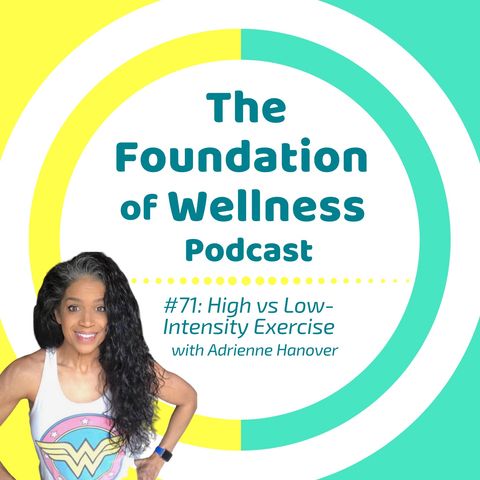#71: High-Intensity vs Low-Intensity Exercise, with Fitness Trainer Adrienne Hanover

Scarica e ascolta ovunque
Scarica i tuoi episodi preferiti e goditi l'ascolto, ovunque tu sia! Iscriviti o accedi ora per ascoltare offline.
Descrizione
#71: High-Intensity vs Low-Intensity Exercise, with Fitness Trainer Adrienne Hanover Intro, Summary, Bio: I’m happy to introduce you today to my longtime friend and former collaborative partner Adrienne Hanover. I...
mostra di piùIntro, Summary, Bio:
I’m happy to introduce you today to my longtime friend and former collaborative partner Adrienne Hanover. I asked her on the podcast today because so many of you expressed interest in learning about high intensity vs low intensity exercise. I posted a poll inside my facebook group, The Foundation of Wellness, and the top request, to my surprise, was high intensity vs low intensity training. And since I am not a fitness excerpt or personal trainer, I wanted to bring someone on who’s fun to talk to, relatable, and experienced in the fitness industry.
In this episode Adrienne explains the difference between High and Low Intensity training, why she prefers to call it High Impact and Low Impact training, who should train for what, and what PHAT is.
Adrienne is no stranger to the fitness world. Having started her career in fitness in 1995 as a personal trainer, group fitness instructor and fitness nutrition coach. Adrienne’s certifications are with NASM (National Academy of Sports Medicine). She’s attained her personal training, Corrective Exercise Specialist, Performance Enhancement Specialist and Fitness Nutrition Specialist.
>>> Join me inside my new facebook group: “The Foundation of Wellness - a Refreshing Diet & Lifestyle Chat”
facebook.com/groups/FOWpodcast
For professional Inquiries contact host Marisa Moon, marisa@ marisamoon.com;
Points of Discussion:
- What’s High Intensity Interval Training?
- Is Low Intensity Exercise as Effective?
- Intensity is Subjective
- “Impact” isn’t as subjective
- High-Intensity with warmup 20-25 minutes
- Low-Intensity minimum 30 minutes or break it up throughout the day
- “The Talk Test” - Heart rate up enough to feel like you’re working, but you can still talk.
- The gas/driving analogy
- High intensity or High Impact is not recommended with injuries
- Work your way up to High Intensity, it’s not for beginners
- HIIT workouts online might be a good at-home test, try one round instead of the full workout
- Listen to your body, you shouldn’t get dizzy or sick with high-intensity
- Take the modifications in a class so you don’t push too hard too fast
- Ignore others’ intensity and focus on what your body is telling you
- Listener questions:
- Difference between High & Low Intensity
- Remember: High intensity pulls from your body’s sugar stores (limited energy supply). Low Intensity pulls from fat stores (virtually unlimited supply)
- What’s the least amount of time needed and how does she know if she’s in the zone?
- You’ll be burning fat no matter what, but more in low intensity
- PHAT: Peripheral Heart Action Training
- Strength Training, alternating upper to lower body
- Key is to keep it moving
- Little-to-no rest between
- No compound movements
- You’re making the heart work to switch blood volume from lower to upper body
- 45 minutes
- You should be sweating
- Start with larger muscles to smaller muscles
- PHAT is a one-stop-shop and the equivalent to HIIT without the high impact moves or much risk of injury
- “Maffetone Formula”, Aerobic Heart Rate Max, Calculated 180-Age = target heart rate for low-intensity and fat burning
- Tip: easier on your joints to put the treadmill on slight incline
- Which is better for building muscle?
- High intensity requires power which helps trigger muscle growth
- Low Intensity can include strength training and build muscle too
- Fast Twitch vs Slow Twitch Muscle Fibers are Genetic Predispositions which can affect how your body responds
- Big difference between muscle “strength” and muscle “endurance”. PHAT is more about endurance.
- Remember to change it up
- Don’t “overtrain” or you risk breaking down muscle for energy
- Weight-training is where it’s at
- help’s with bone density, stability, metabolism, longevity
- Remember protein 30-120 minutes after working out
- 80% of your body composition is determined by what you eat
- Don’t ruin the efforts of your workout with crap food
- “Compensation theory” shows the brain triggering you to eat more calories and more carbs following a workout
- You will be more hungry the more you workout. Make wise choices.
- Don’t eat too closely to a workout (at least an hour before or more)
- Follow Adrienne’s Postpartum Journey after twins and gaining 80 lbs.
Follow Adrienne’s Postpartum Journey on Instagram at @adriefitaftertwins
Train with Adrienne and take some of her classes if you live in Illinois. She’s at the “Life Time Athletic” locations in Vernon Hills, Old Orchard, and Northbrook. Visit: https://www.lifetime.life/life-time-locations/
*** Marisa can be your health coach! It’s affordable and motivational as we tackle your health goals and your daily obstacles together. MarisaMoon.com/consultation and schedule your free call. Come to the facebook group ASAP because I’m giving away a free coaching session to two people, but you have to be in the group. “The Foundation of Wellness”, go to Facebook.com/groups/fowpodcast ***
>> Looking for Toxin-Free Low-Sugar Natural Wine?? Grab your penny bottle of Dry Farm Wines with our affiliate link here: www.dryfarmwines.com/fowpodcast
Marisa's site: https://www.marisamoon.com
Facebook Group: facebook.com/groups/FOWpodcast
Podcast Facebook Page: https://www.facebook.com/FoundationofWellnessPodcast
Instagram: @foundationofwellness_podcast https://www.instagram.com/foundationofwellness_podcast
@marisa_moon_ https://www.instagram.com/marisa_moon_
Intro/Exit Music - "Ukulele Whistle" by Scott Holmes
Commenti

Karen Nasti
4 anni fa
Informazioni
| Autore | Marisa Moon |
| Organizzazione | Marisa Moon |
| Sito | - |
| Tag |
Copyright 2024 - Spreaker Inc. an iHeartMedia Company
